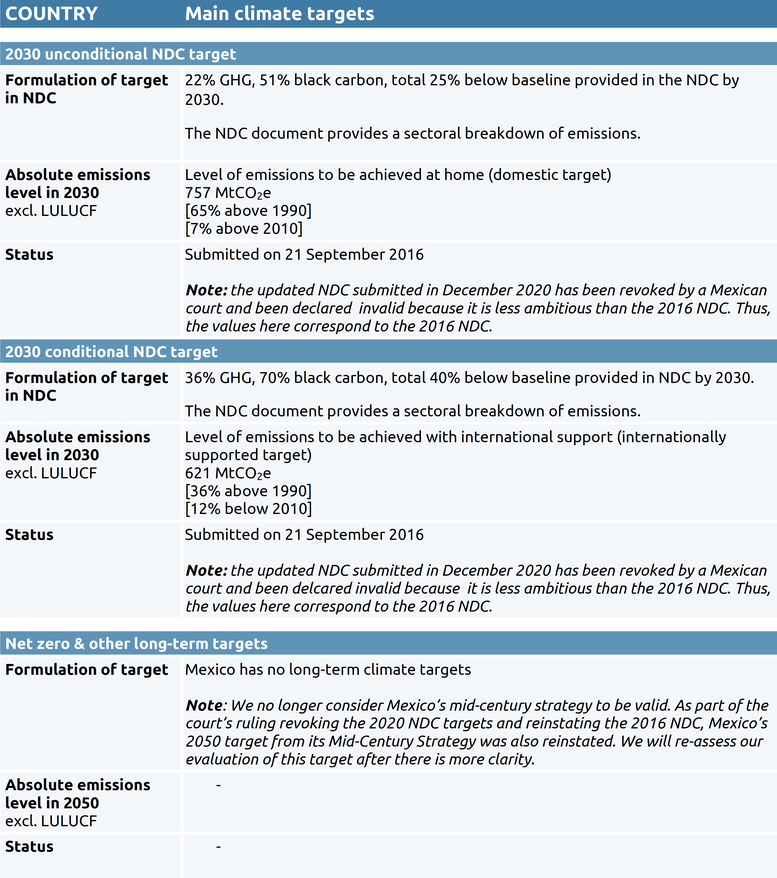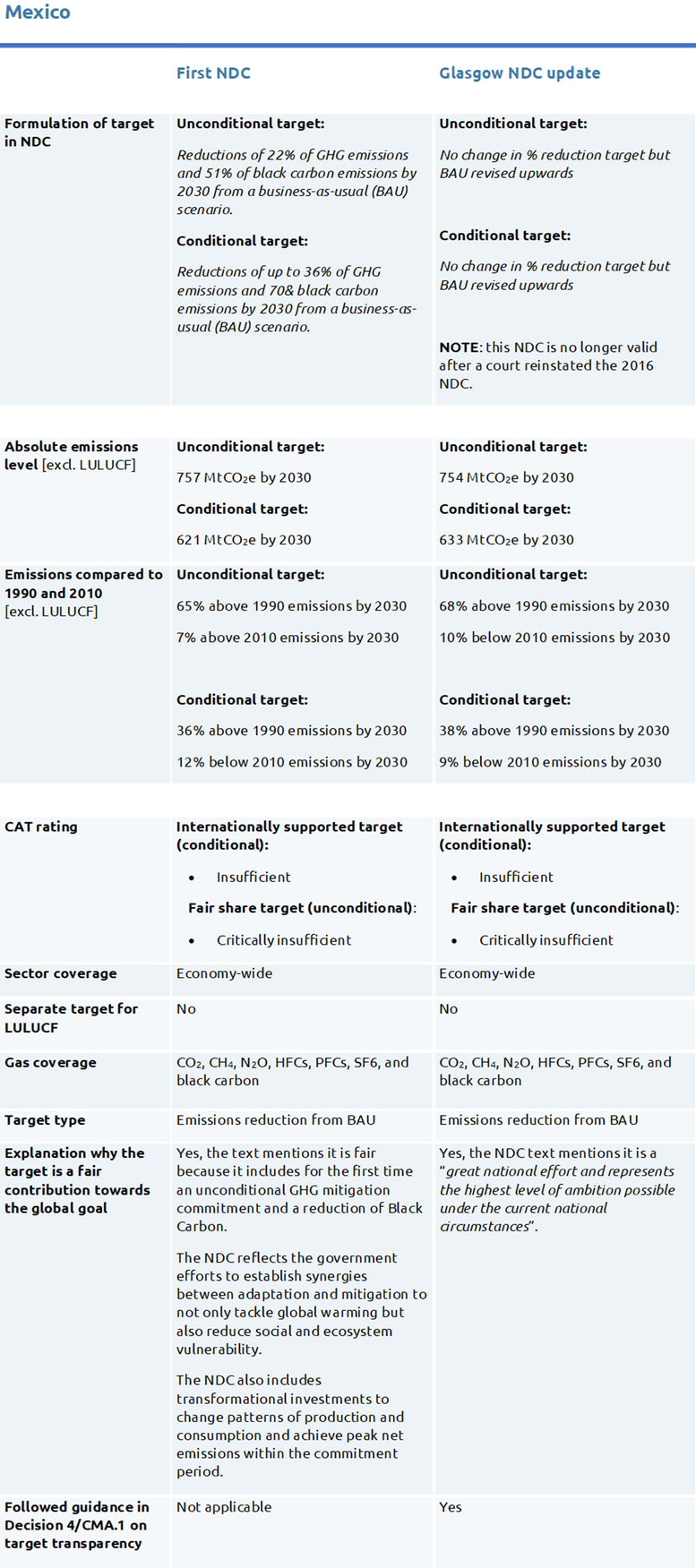Targets
Target Overview
NOTE: Mexico submitted an updated NDC to the UNFCCC on November 17, 2022. The full CAT analysis of the updated target is currently pending.
Mexico submitted an updated NDC to the UNFCCC in 2020 (SEMARNAT, 2020b). This climate target was revoked in October 2021 after Greenpeace México won an “amparo” lawsuit[1] under the argument that Mexico’s updated climate commitment was less ambitious than its 2016 predecessor—contrary to the Paris Agreement and Mexican law (Greenpeace México, 2021; Poder Judicial de la Federación, 2021).
Despite repeating the same percentage reduction under a business as usual (BAU) baseline as the 2016 NDC: to unconditionally reduce 22% of emissions from BAU and reduce by 36% conditional on international support, the updated climate target was less transparent, eliminated the 2026 emissions peak year and provided a higher baseline.
Unfortunately, the amparo decision did not mandate the development of new targets.
In light of the result of the amparo lawsuit, we recalculated Mexico’s unconditional NDC excluding the contribution of the forestry sector as not exceeding 757 MtCO2e in 2030, and its target conditional to international support as 620 MtCO2e the same year using the 2016 BAU baseline. We rate Mexico’s 2030 unconditional NDC target as “Critically insufficient” when compared with its fair-share contribution to climate action, and its conditional NDC target as “Insufficient” when compared to modelled domestic emissions pathways.
Previous estimations of the 2016 target showed slightly different numbers due to a different conversion factor used between global warming potentials (more in the assumptions section).
During the Major Economies Forum on Energy and Climate held by President Biden in June 2022, Mexico mentioned its intention to submit an enhanced 2030 NDC target in line with the Paris temperature goal ahead of COP27 (The White House, 2022).
Mexico submitted a Mid-century strategy in 2016 outlining its intention to reduce greenhouse gas emissions by 50% in 2050 below 2000 levels (Government of Mexico, 2016). This target was also reinstated by the court after the lawsuit against the NDC update. We will re-assess our analysis of this target once there is more clarity.
1 An “amparo is a judicial action to protect an individual or individuals from the acts or omissions of the authorities that violate the human rights and guarantees protected by the Mexican Constitution.” (Mexican Laws in English, n.d.)

NDC Updates
In its 2016 NDC submission, Mexico commits to unconditionally reduce its emissions by 22% below a business-as-usual (BAU) scenario by 2030 and up to 36% below BAU, conditional on receiving financial, technical and capacity building support.
Mexico’s NDC reports emissions levels in 2030 using Global Warming Potentials (GWPs) from the IPCC 5th Assessment Report (AR5) which we converted to GWPs of the IPCC’s Fourth Assessment Report (AR4). Our calculations of the emissions level for the NDC targets, excluding LULUCF emissions, is:
- Unconditional target: 757 MtCO2e in 2030
- Conditional target: 621 MtCO2e in 2030
Absolute emissions are slightly different than in previous assessments due to an updated emissions factor used to convert emissions to global warming potentials from the IPCC’s fourth assessment report—the CAT standard. For further details on the calculations, please see the Assumptions section.
Black Carbon and Mexico’s NDC
Mexico’s NDC includes unconditional and conditional targets to reduce black carbon (BC) emissions, which has substantial co-benefits for human health. However, reductions in black carbon are generally not additional to reductions in CO2 emissions, because large fractions of black-carbon emissions stem from the same emission sources as CO2. Emissions reduction policies therefore often reduce CO2 and black carbon simultaneously, and this is already included in calculations of the emissions reductions in greenhouse gases required to hold warming well below 2°C globally, such as the “emissions gap” and “fair share” reductions (see next section on Fair Share).
From the climate perspective, however, there is no established scientific method to compare the climate benefits of black-carbon reductions to those of CO2 and other greenhouse gases. In the AR5, the IPCC does not provide calculations of GWP for BC comparable to those provided for greenhouse gases, merely noting the inherent difficulties in doing so and limiting itself to just displaying estimates from the pre-AR5 literature. While Mexico’s NDC specifies a metric to compare BC with CO2 (GWP of 900), this is based on a single literature source (pre-dating IPCC AR5), which itself notes the very large uncertainties of around 100%.
Comparison table

Target development timeline & previous CAT analysis
CAT rating of targets
The CAT rates Mexico’s internationally supported target as “Insufficient” and its fair share target as “Critically insufficient”.
Internationally supported target
We rate Mexico’s conditional 2030 reduction target levels as “Insufficient” when compared to modelled emissions pathways. The “Insufficient” rating indicates that the target needs substantial improvements to be consistent with the 1.5°C temperature limit. If all countries were to follow Mexico’s approach, warming would reach over 2°C and up to 3°C. Our rating system suggests that Mexico should receive limited international support to get on a 1.5°C compatible pathway.
Fair share target
We rate Mexico’s 2030 NDC target as “Critically insufficient” when compared with its fair-share contribution to climate action. The “Critically insufficient” rating indicates that Mexico’s fair share target in 2030 reflects minimal to no action and is not at all consistent with the 1.5°C temperature limit. Mexico’s target is not in line with any interpretation of a fair approach to meeting the 1.5°C limit. If all countries were to follow Mexico’s approach, warming would exceed 4°C.
Further information on how the CAT rates countries (against modelled pathways and fair share) can be found here .
Further analysis
Latest publications
Stay informed
Subscribe to our newsletter




